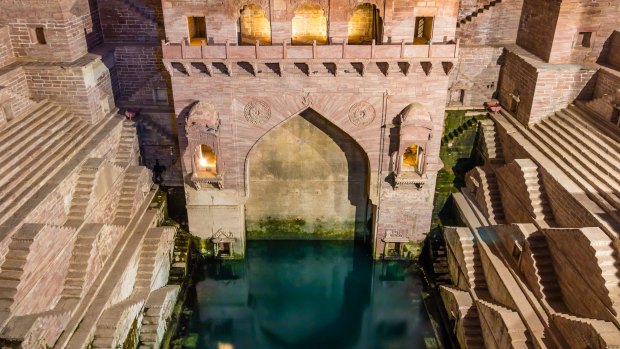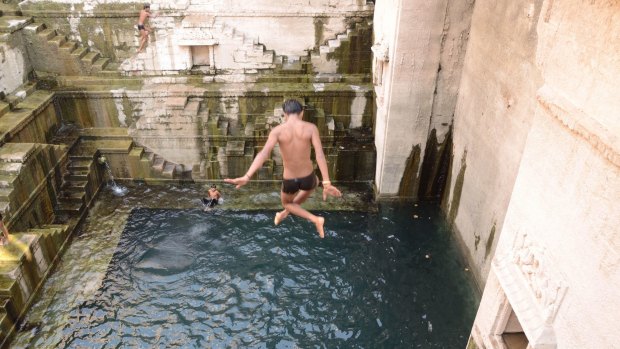This was published 5 years ago
Rajastan, India: Jodhpur's boutique RAAS hotel home to rare piece of heritage

The Toor ji ka Baori (Toor ji stepwell) in Jodhpur,Credit: SHUTTERSTOCK
It's not quite the swimming pool conduct you'd expect at a five-star hotel, yet on my arrival at my accommodation in Jodhpur, a group of adolescent boys, their wet brown torsos gleaming in the hot afternoon sun, are leaping, diving and, yes, dive bombing, from fearful heights into the deep emerald waters below them.
Such is their collective derring-do that I almost consider scrawling scores onto some stray scraps of cardboard and displaying them after every breathtaking feat, each one ending with a detonation of water that echoes like a depth-charge between cavernous stone walls.
Of course, all is not entirely as it appears. This hotel "swimming pool" is in fact an ancient stepwell in the shadows of Jodhpur's 15th-century Menrangarh Fort. There remains, however, a direct and intriguing connection to the hotel. The stepwell is located just outside the boundaries of RAAS Jodhpur, an architecturally-stunning, and stunningly-located, 39-room heritage property.

Aqua acrobatics at the The Toor ji ka Baori (Toor ji stepwell) in Jodhpur, India.Credit: Dinodia Photos / Alamy Stock Photo
Inside the hotel proper there's a perfectly conventional guest swimming pool where such antics, as described, are strictly prohibited. But it's the extraordinary stepwell that really concentrates my attention. Officially called Toorji Ka Jhalra, the 18th-century stepwell represents an important and unique part of the hotel. It was meticulously restored by RAAS's owners and today represents one of India's most remarkable examples of urban rehabilitation.
Stepwells, which can reach depths of tens of metres, were conceived centuries ago as ingenious methods of water-harvesting and storage but even here in India they have been superseded by modern-day plumbing and water management techniques, with many of them, such as Toorji Ka Jhalra before its recent rehabilitation, becoming virtual cesspits and de facto receptacles of waste.
During the Raj era, the British could not recognise the benefits of stepwells and filled in many of them but large numbers still exist, albeit in various states of disrepair and neglect, largely overlooked, not just by locals but also by visitors to the subcontinent.
In the preface to the sumptuous book, The Vanishing Stepwells of India, by Victoria Lautman, Divay Gupta, an Indian architecture authority, writes that stepwells such as the one here in Jodhpur are among India's most under-appreciated man-made wonders.
"Stepwells were no less magnificent in their conception, architecture and ornamentation than the temples and palaces of their times," Gupta writes. "India's temple architecture is well-documented and much studied [but] in contrast, stepwells have never received the attention they deserve."
Indeed, while hundreds, if not thousands, of temples and palaces across India have been restored, stepwells have been all but abandoned. Pause long enough to study and appreciate them, and you will discover that, with their intricate design and decoration, they are ingenious triumphs of engineering and geometry, at once complex and yet remarkably simple.
"A flight of steps adjacent to the well cylinder ensured that groundwater could be accessed even when it retreated to the lowest trickle," writes Lautman. "As the flow increased, the steps became submerged, and any descent was significantly shortened. As the water receded once again, more steps reappeared."
Unique to the subcontinent, stepwells were constructed to harvest the waters from India's dramatically variable climate which in parched states such as Rajasthan, where Jodhpur is situated, sees the weather range from the scorching heat of summer to the epic torrents of the monsoon season.
The task of collecting water from the stepwell was the daily responsibility of local women. But stepwells didn't just provide a vital source of water, and a cool place in which to shelter in the hotter months, they also emerged as a place of devotion where ritual purification and prayer at the heart of Hinduism were performed by both genders and all ages.
Until recently that was the case here in Jodhpur where Toorji Ka Jhalra has been revived as part of an ambitious, largely private-sector-led urban regeneration project.
Its resurrection involved the disposal of hundreds of truckloads of garbage that had been removed from the toxic waters of the crumbling stepwell, which makes the sight of teenage boys joyously immersing themselves in it today all the more remarkable. Nowadays, the daily task of keeping the stepwell clean falls to the staff of the hotel rather than local authorities.
The stepwell, built from Jodhpur's distinctive rose-red sandstone, features extensive intricate carvings of dancing elephants and medieval lion and cow water sports, many of which were uncovered during restoration. A so-called Persian wheel, operated by pair of bullocks at ground level, once drew water up to two different access points at the stepwell.
Yet the owners of the stunningly-located hotel didn't stop at the stepwell in their restoration efforts. Amid the familiar squalor and chaos that distinguishes Indian cities they also created Stepwell Square around the main antique water feature. It consists of various upmarket boutiques in surrounding buildings.
Stepwell Square and RAAS Jodhpur are positioned directly beneath the ramparts of Mehrangarh Fort, one of the largest in India and itself a model of restoration. Built about 1460 by Rao Jodha, the fort is situated 125 metres above the so-called "blue city", where pockets of buildings are still painted blue, and is enclosed by imposingly solid walls.
Inside the hotel compound itself, contemporary buildings are skilfully designed and built in and around an original 18th-century haveli and courtyard gardens while original buildings are deftly interspersed with subtle modern additions.
The centrepiece is Darikhana, also known as the Chamber of Carpets, which was constructed towards the end of the 18th century and served as the haveli's guest-house. Today, it functions as one of the hotel's restaurant spaces and also hosts a magnificent al fresco roof-top bar from which striking views of the floodlit fort looming above can be enjoyed. Elsewhere, across the courtyard, is a building dating back to the 1850s that served as the haveli's entertainment pavilion and now operates as the hotel's main restaurant.
Inside RAAS Jodhpur I've scored the coveted Stepwell Suite. It is perched atop a small Hindu temple at street level and, as its name suggests, directly overlooks the stepwell. From here I'm able to monitor the daily happenings in and around the stepwell, which has been re-embraced by the citizens of Jodhpur.
In the mornings, locals arrive to toss feed for the fish into the water while a holy man of some sort positions himself with a rug in a shaded corner to greet and counsel followers. Then there's a post-dawn fashion shoot with a model posing on the steps of the well, careful not to trip over her flowing dress and tumble in.
True, the stepwell, with its precarious steep steps, and no safety barriers, has its dangers. I learn of a military man who, early one morning this year, after a night on the town with colleagues, lost his balance and fell to his death. Stepwells are not a place for selfies.
With each of our April days becoming hotter than the next, the teenage boy divers I observed on my arrival return to the ornate heights of the stepwell in the afternoons, resuming their display of death-defying acts, the crash of yet another depth-charge splash of water reverberating between the walls of the resuscitated stone and water marvel.
Anthony Dennis travelled as a guest of the Classic Safari Company and Singapore Airlines.
FIVE MORE THING TO SEE AND DO IN JODHPUR
1. MARVEL AT MENRANGARH FORT
Aside from their immense architectural merit, the series of palaces within this sprawling complex house a museum containing the personal collection of the maharaja.
2. EXPLORE THE GROUNDS OF JASWANT THADA
Following the essential pilgrimage to the fort, head to Jaswant Thada, a white marble cenotaph honouring Jodhpur's former rulers, surrounded by attractive gardens.
3. WANDER THE STREETS OF THE BAZAAR
Inside Jodhpur's nearly 10 kilometre-long city wall is the labyrinthine old city composed of crowded, narrow and intriguing laneways bursting with life.
4. VISIT THE UMAID BHAWAN PALACE MUSEUM
Although the five-star hotel within the grandiose 1940s maharaja's palace is off-limits to all but house-guests there's a so-so public museum that allows for a peek at the building.
5. SHOP FOR EXQUISITE TRADITIONAL TEXTILES
Rajasthan is renowned for its traditional textiles and Jodhpur is home to Om Ganesh Export House, the exquisite local fabrics of which are highly sought after by European fashion houses.
TRIP NOTES
MORE
FLY
Singapore Airlines operates multiple daily flights from Sydney and Melbourne, to Singapore, with twice daily connections to Delhi. There are one-and-a-half-hour domestic connections to and from Jodhpur and Delhi with major domestic carriers. See singaporeair.com.
STAY
A stay at RAAS Jodhpur can be booked as part of a tailored package private tour of Rajasthan arranged by the Sydney-based Classic Safari Company. Rooms start from $383 in high-season. See classicsafaricompany.com.au
Sign up for the Traveller Deals newsletter
Get exclusive travel deals delivered straight to your inbox. Sign up now.